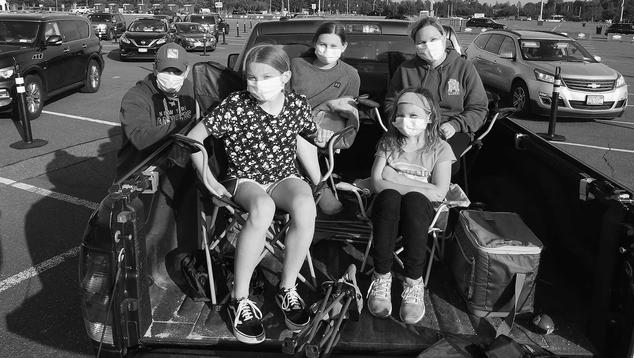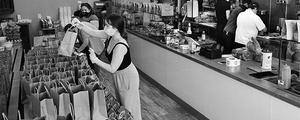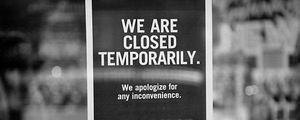Story Highlights
- No reduction in avoiding public places or traveling in recent weeks
- Fewer are avoiding small gatherings, such as with friends and family
- Almost three in 10 ready to get back to normal right away
WASHINGTON, D.C. -- Americans continue to avoid situations where they may encounter other people and are wary of resuming their normal activities, according to the latest week of Gallup's COVID-19 tracking. However, the percentages isolating themselves have come down from their peaks in April, with a further decline in avoiding small gatherings seen in the past week.
The following key findings are based on Gallup Panel interviews with national adults conducted via the web for the week ending May 31, just as protests against police violence were erupting across the country.
Most Still Sheltering, but More Enjoying Small Gatherings
After peaking at 84% near the start of April, Americans' avoidance of small gatherings of people, such as with friends and family, continues to decline -- with a six-percentage-point drop in the past week to 56%. Americans are now as likely to be avoiding small gatherings as they were in the third week of March, as social distancing was still ramping up.
Meanwhile, much larger majorities of Americans continue to report they are avoiding traveling and going to public places like stores or restaurants. These behaviors have held firm over the past three weeks.
Likewise, wearing face masks outside the home remained at the peak level of 83% that was reached the prior week.

Line graph. Tracking Americans' social contact behavior from March 13 through May 31, 2020. The public is most likely to say they are wearing a face mask outside their homes (83%). Majorities are also avoiding public transportation (74%), public places (64%) and small gatherings (56%).
Perhaps reflecting that more Americans are getting together with friends and family, fewer say they are completely or mostly isolating themselves from nonhousehold members, while more say they are partially isolating.
Still, even as the percentage practicing extreme social distancing wanes, relatively few -- now 23% -- say they are isolating themselves "a little" or making no attempt at doing so.

Line graph. Tracking the degree to which Americans are isolating themselves from nonhousehold members between March 16 and May 31, 2020. The latest figures show fewer Americans are completely or mostly isolating themselves (49%) than at any point since the beginning of the trend. Twenty-eight percent are partially isolating and 23% are making a little or no attempt to isolate.
A separate Gallup measure asks Americans how often they practiced social distancing in the past 24 hours. The percentage saying they "always" practiced it peaked at 65% in early April but fell to 50% in early May and dropped further to 44% in the latest poll. Thus, not only are Americans not isolating themselves as much, but it appears they are easing off on social distancing practices when they do encounter others.
Americans Not Ready to Resume Normal Daily Activities
Most Americans remain reluctant to return to their normal routines, consistent with the trend over the past month. Asked when they would resume their normal daily activities if there were no government restrictions, 29% say they would do so "right now," similar to the 24% to 28% seen throughout May.

Line graph. Percentage of Americans who would resume normal activities right now if it were up to them between April 6 and May 31, 2020. Currently, 29% would resume compared with the lowest reading of 13% from April 6-12.
Since April, when Gallup started asking Americans when they would ideally get back to normal if it were up to them, the public has grown more likely to say "right now" as well as to say they would wait until after a vaccine is developed -- the latter being the most cautious approach of the four offered in the question.
Fewer now opt for the middle approaches of waiting until after the number of new cases in their state has declined significantly or until there are no new cases.
| April 6-12 | May 25-31 | Change | |||||||||||||||||||||||||||||||||||||||||||||||||||||||||||||||||||||||||||||||||||||||||||||||||
|---|---|---|---|---|---|---|---|---|---|---|---|---|---|---|---|---|---|---|---|---|---|---|---|---|---|---|---|---|---|---|---|---|---|---|---|---|---|---|---|---|---|---|---|---|---|---|---|---|---|---|---|---|---|---|---|---|---|---|---|---|---|---|---|---|---|---|---|---|---|---|---|---|---|---|---|---|---|---|---|---|---|---|---|---|---|---|---|---|---|---|---|---|---|---|---|---|---|---|---|
| % | % | Pct. pts. | |||||||||||||||||||||||||||||||||||||||||||||||||||||||||||||||||||||||||||||||||||||||||||||||||
| Right now | 13 | 29 | +16 | ||||||||||||||||||||||||||||||||||||||||||||||||||||||||||||||||||||||||||||||||||||||||||||||||
| After number of new cases in your state declines significantly | 40 | 32 | -8 | ||||||||||||||||||||||||||||||||||||||||||||||||||||||||||||||||||||||||||||||||||||||||||||||||
| After no new cases in your state | 40 | 26 | -14 | ||||||||||||||||||||||||||||||||||||||||||||||||||||||||||||||||||||||||||||||||||||||||||||||||
| After vaccine developed | 7 | 12 | +5 | ||||||||||||||||||||||||||||||||||||||||||||||||||||||||||||||||||||||||||||||||||||||||||||||||
| Select trend | |||||||||||||||||||||||||||||||||||||||||||||||||||||||||||||||||||||||||||||||||||||||||||||||||||
| Gallup Panel, 2020 | |||||||||||||||||||||||||||||||||||||||||||||||||||||||||||||||||||||||||||||||||||||||||||||||||||
No Indication From Americans That Social Distancing Is Deteriorating
As Americans start to interact more with others, at least in small gatherings, one might expect to see heightened public concern that people aren't exercising enough caution. So far, that hasn't happened, as a consistent 45% to 48% in recent weeks have said they are very or moderately worried about a lack of social distancing in their area.
In the latest week, 12% were very worried, 34% moderately worried, 28% not too worried and 26% not worried at all.

Line graph. Percentage of Americans who are very or moderately worried about a lack of social distancing in their area, between April 6 and May 31, 2020. Currently, 46% are very/moderately worried, which is consistent with recent measures.
Bottom Line
Americans are still social distancing but are doing it a bit differently than in the first month of the crisis. Early on, they suspended most or all contact with nonhousehold members. Today, by comparison, fewer are avoiding public places and travel, but the biggest shift has been in renewing visits with friends and family. Whether social distancing is being maintained in these encounters, such as by keeping six-foot distances between people, isn't clear. However, with more than eight in 10 Americans reporting they are wearing face masks when out in public, there is a chance that many are still trying to socialize responsibly.
Learn more about how the Gallup Panel works.




